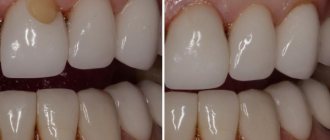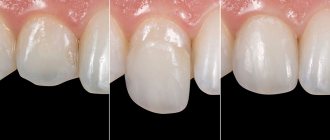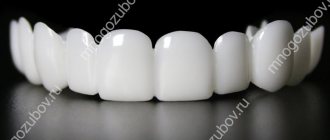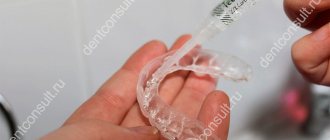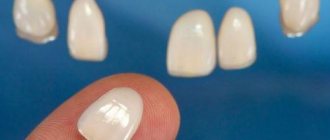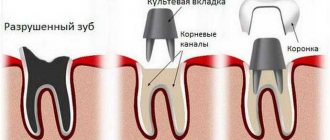A beautiful smile helps you feel more confident and attractive; it has long become an integral part of the image of a modern and successful person. But alas, ideal, even and snow-white teeth are given by nature to a few, and in addition, under the influence of various external factors, tooth enamel can lose its attractive shade, and chips and cracks may appear on the surface of the teeth. All these defects negatively affect the aesthetics of a smile and make a person feel embarrassed about it.
But all these problems are completely solvable - just contact the dentist for the service of installing veneers on your teeth.
Veneers are a special type of orthopedic microprostheses that are applied to the outer surfaces of teeth and ideally mask aesthetic defects in the dentition. In the article we will analyze in detail the indications and contraindications for installing veneers on teeth, the pros and cons of restoration overlays, and consider different types of structures with photos.
Calculate the cost of treatment by taking a short test in 20 seconds!
Do not delay your treatment, because in this matter time plays against us.
What are veneers
Veneers are thin composite or porcelain overlays, no more than 0.5 millimeters thick. Using dental cement, they are attached to the outside of the tooth and mask minor enamel defects: violations of color, density and integrity.
The first veneers appeared in America in the 30s of the twentieth century. They were invented by dentist Charles Pincus specifically for Hollywood stars so that they could shine with a perfect smile on camera. The first plates were attached with an adhesive mixture, which held them on the teeth for no more than 2-3 days.
Modern veneers bear little resemblance to their ancestors, but just like them, they perfectly cope with the task assigned to them - to achieve an ideal aesthetic effect in the shortest possible time.
Lumineers
Lumineers are the most expensive and completely harmless option for creating a beautiful smile. They are very thin plates of porcelain. They are 2 times thinner than veneers, much stronger and look more natural in the oral cavity. To install them, no additional treatment of the teeth is required (part of the enamel is not worn down). Installed in a short time and absolutely painlessly. Such dentures are manufactured only in America; in this country there is a special laboratory for their manufacture, where the technology for the production of dentures - lumineers - was patented. The main advantage of such onlays is that they can be removed at any time without damaging your teeth. The installation of lumineers is harmless, does not affect the sensitivity of the enamel and does not cause discomfort.
With the introduction of technology in the dental services market for the production of veneers and lumineers, many people have the opportunity to achieve a beautiful Hollywood smile. Only a small number of people are born with beautiful and straight teeth. The biggest disadvantage of creating such a smile is the very high cost. Despite this factor, installing veneers can make your long-standing dream come true - to have snow-white and straight teeth. Making braces and regular chemical teeth whitening together will not cost much less.
Sources used:
- “Ceramics in Dental Restorations – A Review and Critical Issues.” Azom. October 8, 2002
- “Criteria for evaluating composite dental restorations” (Nikolaev A. I.)
- Principles of operative dentistry. Qualtrough, A. J. E. Oxford, UK: Blackwell Pub. 2005.
Advantages of veneers
The main advantage of veneers is the ability to completely transform the patient’s appearance in the shortest possible time. And, indeed, the possibilities of the overlays are impressive! With their help, the dentist can make the enamel lighter by several tones, lengthen the tooth, straighten it, and fill the gap between the front teeth.
A shining white smile is a sign of youth, so after installing veneers, get ready to listen to compliments: visually, the procedure allows you to lose 10-15 years.
In addition to aesthetic problems, veneers can also be installed for medical reasons, for example, with increased tooth wear. Often, onlays help solve minor orthodontic problems.
The following also speaks in favor of veneers:
- Durability. If you follow all the dentist’s instructions, the plates will last on your teeth for at least 10 years. And sometimes their service life is two or even three decades. Technologies for the production of veneers are constantly being improved, and today dentists can proudly say that they have achieved such strength in veneers that the risk of chipping has become less than that of all-ceramic crowns.
- Invisibility . Restoration using veneers is completely invisible to others. Visually, the teeth look as natural as they did before the procedure: the natural shape and surface texture are preserved, and the color is selected individually for each patient.
- Hypoallergenic . The materials used to create veneers are completely biocompatible: they simply cannot cause an allergic reaction in the patient.
- Resistance to dental plaque . It simply does not form on veneers!
- Resistance to dyes . Everything that had such a negative impact on the condition of the enamel before: cigarette smoke, coffee, tea, red wine will not leave a trace on the surface of the veneers. They will never stain. Throughout their service life, the linings will retain their original appearance: they will not become cloudy or discolored.
It is very important that veneering allows you to preserve healthy tooth tissue as much as possible. Unlike grinding for crowns, tooth preparation before installing a veneer involves removing the enamel only to the thickness of the porcelain plate: from 0.5 to 0.75 millimeters.
Installing veneers on diseased teeth or gums is strictly prohibited! It is also impossible to install a structure on a tooth with a significant chip - in this situation only a crown will help.
The edge of the veneer is so thin that dentists do not need to hide it under the gum. This means that after the procedure the patient will not experience any discomfort, and even more so, he will not have the sensation of a foreign body, as often happens with prosthetics.
Free consultation on the cost of treatment in our dentistry
Leave a request and the clinic administrator will contact you within 15 minutes!
Lumineers: features and photos
Lumineers are ultra-thin ceramic microprostheses. Their thickness does not exceed 0.3 millimeters. Due to this, preliminary grinding of tooth enamel when installing lumineers is not necessary. The doctor will thoroughly clean the tooth enamel and then attach lumineers to the tooth surfaces.
Unlike other types of veneers (except composite), lumineers can be removed after installation without damaging the natural enamel layer and return the teeth to their original appearance.
It is worth noting that grinding of tooth enamel during lumineing cannot always be avoided. For example, if the purpose of restoration is to eliminate crowding of teeth, preliminary preparation of the teeth will be carried out. Lumineers are recommended by experts to solve the problem of unexpressed defects of dental surfaces - darkening of the enamel, chips. If the patient has pronounced interdental spaces and curvature of the teeth, experts recommend veneering.
Zirconium veneers: characteristics and photos
Microprostheses of this type are made from a special material – zirconium dioxide. In terms of strength and service life, zirconium surpasses all other types of dental materials. It is resistant to mechanical stress and the influence of aggressive substances, and allows you to choose the shade of veneers to match the natural color of your teeth enamel. At the same time, the plates have transparency and a pleasant natural shine, allowing you to get an impeccably beautiful smile.
Zirconium veneers for teeth are produced using innovative technology - computer modeling and CAD/CAM milling. First, a zirconium frame is made, which is then coated with dental ceramics. Thanks to the use of modern technologies, ready-made veneers fit perfectly to tooth surfaces, do not stand out visually, and cannot be distinguished from natural teeth.
Zirconium veneers on teeth have the longest useful life – up to twenty years. Of course, structures can last for so long only if high-quality oral hygiene is observed and all doctor’s recommendations for caring for installed veneers are followed.
Cons of veneers
At first glance, veneers have only one drawback – their high price. Indeed, the cost of an onlay is no less than a high-quality metal-ceramic crown. But the service life of the latter exceeds the life expectancy of the veneer by 2-3 times. And this would not be so sad if ceramic plates could later be abandoned.
But, alas! To install a veneer, a healthy tooth will need to be sharpened. Not much, but enough to deprive its surface of natural protection from chemical, mechanical and thermal irritants. And if the patient wants to return to his natural teeth, they will need restoration, which is rarely done without filling materials.
Important! Veneers are not stained by tobacco smoke or coloring products. But the natural edges of the tooth, which barely protrude from under the lining, react to dyes as before. Therefore, you will still have to change your eating habits, just like giving up smoking.
And if a would-be dentist gets down to business, the harm to the teeth can be even more significant. The most common problems that patients encounter after installing veneers:
- Changing the color of the record . This happens if the process of preparing the tooth for installation of the structure was disrupted. The problem is solved by polishing the denture.
- Development of increased sensitivity of teeth . This symptom indicates improper fixation of the veneer on the tooth surface. It is difficult to predict the development of the situation: perhaps the patient will be helped by coating the tooth with a fluoride-containing agent. But it is possible that the pain is caused by caries developing under the structure. Only a dentist can determine the exact cause of discomfort.
- Injury to the gums by the edges of the ceramic veneer in the area of the tooth neck.
- Chip of veneer . Most often, this happens several years after the installation of onlays, when the cutting edge of the patient’s tooth has worn away.
- Detachment of the onlay from the tooth . When installing veneers, doctors warn about their fragility and give detailed recommendations for care. If you do not follow them, the service life of the veneer can be significantly reduced.
Still, the main disadvantage of veneers is that they are exclusively a cosmetic solution. And healthy, strong-looking teeth do not become stronger and more durable when ceramic plates are installed on them.
Benefits and harms of veneers
Veneers, the benefits and harms of their installation is an important point when choosing a method of tooth restoration. Many people wonder: is it worth installing veneers if you can go with braces to restore your bite and create a beautiful smile. This issue is very controversial. If you naturally have beautiful color and shine to your teeth, then you should get braces. But not everyone has naturally white and straight teeth. It will take at least a year to wear braces, but installing veneers will take a maximum of two weeks.
The benefits of veneers are noticeable even over time. It allows you to make your smile amazing in the shortest possible time, without making any effort. Another benefit from them is that you don’t need to completely grind down the tooth, you just need to clean up the enamel a little for better adhesion of the plate to the tooth. The service life of this type of dental service is quite long. Often, with a high-quality veneer you can last about 20 years. This indicator directly depends on proper care of the veneers and the absence of bad habits that contribute to the destruction and damage of the veneer.
The biggest harm that veneers can cause is cutting down part of the enamel. It will no longer be possible to refuse to wear them. After the first installation, you will have to wear them for the rest of your life. Or after removing the onlays, it will be necessary to completely restore the tooth enamel, which is almost impossible without the use of filling materials. Another harm that installed veneers can cause is that teeth can become sensitive to many factors. Many people often experience toothache under veneers - this is often associated with an increased reaction to temperature stimuli (you cannot eat very hot or cold). In such a situation, you will have to contact your dentist again, who will order an X-ray of the jaw. Only after this will it be possible to determine the cause of tooth pain under veneers.
Indications for installation
Dentists usually suggest thinking about installing veneers to those patients for whom enamel whitening has proven ineffective, for example, with incomplete amelogenesis, fluorosis, so-called tetracycline teeth.
Moreover, sometimes these 2 procedures very often go hand in hand: first, the doctor lightens the enamel, waits at least 2 weeks for the natural shade of the teeth to be restored. Then the color of the veneers is selected and they are installed. This approach allows you to brighten your smile as much as possible.
In addition to lightening tooth enamel, indications for installing onlays are:
- traumatic chipping of a front tooth;
- unaesthetic gaps (trema and diastema) between teeth;
- pigmentation of the filling and pigment spots on the tooth tissue around the restorative structure;
- any non-carious defects of enamel and dentin;
- cracks on the tooth;
- exposure of the tooth root - gum recession.
For patients with a deep bite, veneers will be a good alternative to a crown, since in this case there is too little space on the oral surface of the teeth to install an oversized structure.
Discount on veneers up to 30%! Details from administrators
Moscow
Only a doctor can say for sure whether it is possible to correct a particular defect by installing veneers. You can always ask other questions about ceramic and composite onlays in our dental center. Professionals work here, who every day give their patients the opportunity to smile without embarrassment.
What kind of design is this and its features
What kind of dentures are these and how are removable dentures different from all the others? Removable veneers are veneers that can be removed. It would seem nothing complicated. But in this simplicity lies either an advertising ploy - it misleads patients, or such veneers will soon have to be replaced with permanent ones - which in theory they should be.
It is worth saying that not a single self-respecting orthopedic dentist will offer a patient removable “veneers” as an option to improve the aesthetics of a smile. What's the point here? In general, veneers1 are non-removable microprostheses - overlay plates on the upper and lower front teeth, which make them more beautiful in shape and shade. But such onlays are made in a dental laboratory (this is important!) within a few days or weeks. During this time, the patient is given temporary plates - composite or plastic, which will soon be removed. They are needed to protect the ground teeth from damage and temporarily give them a natural look.
Those removable veneers that are offered to patients on websites on the Internet or in advertising videos and booklets are most often similar to conventional silicone dentures for the entire jaw. They also resemble the joke “jaws” that people wear to masquerades, and even chewing gum in the shape of jaws. They attach very poorly to the mouth and, according to patients, they are completely impossible to wear. You can see how “natural and natural” such products look before and after installation - see the photo.
Contraindications and restrictions
Unfortunately, in some cases, veneers are contraindicated as a means of restoring the aesthetics of a smile. For example, when:
- large-scale destruction of the front teeth;
- multiple fillings on the front teeth;
- malocclusion: veneers can further aggravate the situation;
- pathological grinding of teeth - bruxism. Under constant load, the linings will become unusable too quickly;
Dentists do not recommend installing veneers for those patients who are not willing to spend extra minutes of precious time on dental care.
Until recently, the removed pulp was an absolute contraindication for installing veneers. But today technology has stepped forward, and this issue is resolved individually.
Cost and service life
Veneering is an artistic restoration that involves individual work by a specialist with each individual client. This work is intricate and painstaking, so you should not skimp on choosing a competent specialist. The cost of veneers varies greatly depending on the material chosen and installation method. Naturally, it is cheaper to install one plate than to correct an entire row of teeth, but the veneer may stand out slightly against the background of natural teeth. The client has the opportunity to choose veneers from a filling material, but it is worth recalling that the service life of such products is shorter, so additional financial expenses will soon arise for their replacement. It makes sense to initially think about installing higher-quality microprostheses, which will ultimately be more profitable. The price includes not only the veneers themselves, but also the use of high-quality, innovative equipment, and the work of specialists - a dentist and a dental technician.
If the procedure is carried out correctly, veneers can last quite a long time. It is equally important to consider the material from which the linings are made. Composite microprostheses can not be changed for 4-5 years, subject to careful oral care. Ceramic veneers last longer and do not lose their appearance over time; on average, patients wear them for more than 10 years.
Despite the fact that dental veneers have become one of the most popular and sought-after techniques for achieving a flawless smile, it is still worth making the decision yourself, having carefully considered the pros and cons. If there are no direct indications, but there is only a desire to correct your smile and make the enamel whiter, then it is better to consult a dentist and find other ways to achieve what you want without damaging your teeth.
Calculator: calculate prices online
Calculation of the cost of turnkey veneers
Calculate the cost of installing veneers yourself.
For an accurate final calculation, the cost of fixation is added to each veneer - 500 rubles. and once for the entire work, the cost of casts is 1200 rubles.
Choose the type of veneers
0
Please indicate the required number of veneers
Better and more accurate - in a free consultation! All addresses and telephone numbers are on the website chudostom.ru. Make an appointment by calling the branch closest to you.
The calculation is not a public offer; the final cost is determined at a free consultation BEFORE the start and does not change during the treatment process.
Total cost rub.
Types of veneers
The entire variety of veneers that dental clinics offer can be combined into 2 large groups:
- therapeutic veneers, composite;
- orthopedic, made of dental ceramics.
Composite veneers are inexpensive but durable. Unfortunately, they are not transparent enough and it is almost impossible to achieve complete resemblance to the patient’s natural enamel color. In addition, composite veneers become cloudy, darken and change their shade over time. And even with the most careful handling, they will not last longer than 5 years.
The use of composite veneers is justified if there are isolated violations of the aesthetics of the dentition, for example, a small spot on a tooth.
Ceramic veneers allow you to restore the entire dentition, and at the same time the veneers will remain practically invisible to others. Ceramic veneers last a long time: at least 10 years. This indicator, like the strength characteristics, depends on the composition of the ceramic mass:
- veneers based on zirconium dioxide are not subject to aging. They are not stained with food dyes and do not lose their shine over the years. The linings can withstand heavy loads, and therefore their minimum service life is 20 years;
- veneers on an aluminum dioxide frame are easier to install and require less grinding of teeth, since their thickness is only 0.25 millimeters. Their installation is indicated for people prone to allergic reactions, since aluminum dioxide is a fully compatible biomaterial.
What materials are they made from?
Overlay removable veneers are made of polymers, silicone, polypropylene, and plastic in light shades. These are inexpensive materials, they are easy to process and can be easily painted in enamel colors. But we must understand that even in professional dentistry such materials are used only on a temporary basis, because they have low performance characteristics. The materials are softer and more fragile than those used for real microprostheses. They also have irregularities and pores on the surface, into which dietary fiber and dyes become clogged.
How can I replace veneers?
Science does not stand still, and today the most modern clinics can offer a more advanced alternative to veneers:
- ultraneers or E-max veneers
. Very thin, fragile, compared to traditional types of veneers. They are made of pressed ceramics and are almost not felt by the patient while being worn; - Lumineers
_ The thinnest plates available today, the installation of which does not require grinding of the tooth. That is why lumineers can always be removed, because their installation does not harm the enamel in any way. Lumineers look very natural, and their service life is at least 20 years! The only drawback of such dental restoration is the high price.
The production of lumineers is patented by the American laboratory Cerinate, which has the exclusive right to manufacture them. Therefore, the offer of unscrupulous dentists to install more affordable lumineers from another company should immediately raise your alarm!
How to use removable veneers
How to install and remove removable “veneers” will depend on their type. If the product is in the shape of a full jaw, then they are simply put on the teeth from above and removed from them by hand. Some sellers write that you first need to put the structure in hot water for a few minutes - almost boiling water - and then put it on. But in this case, there is a real risk of burning the gums and overheating the dentinal layer (it is located under the enamel), which can provoke pulpitis. Not to mention the discomfort of the installation process - some people report that it is painful or too hot for the teeth.
Removable “veneers”, which imitate real ones in their shape (but are sold in packs of 70 pieces, and are not made individually), are supposed to be fixed with a special adhesive using a brush and tweezers. And all this on your own at home. But if dentists use only professional formulations with proven components, then it is completely unknown what will end up in the package with “veneers”. It will be good if it is harmless glue (even if it comes off quickly). And if you come across a toxic substance that is difficult to remove, you will have to urgently seek medical help.
Why are veneers so expensive?
The cost of veneers is influenced by many factors. And the most important of them: the price of the material and the manufacturing method. Thus, composite onlays, which are formed directly in the patient’s mouth, cost no more than installing a crown. But the manufacture of ceramic veneers requires high professionalism and a significant investment of time from the dentist and dental technician.
First, an imprint of the tooth is made, then an impression is made, from which the technician will manually sculpt the future plate layer by layer. The process of making veneers is completed by firing in an oven. Thus, the creation of an onlay that is visually indistinguishable from a tooth can only be compared with the birth of jewelry: the work must be so professional and precise. And, of course, it simply cannot be affordable!
Author: Alexander Yaganov Orthodontist. Work experience more than 7 years.
The information is for reference only. Before treatment, consultation with a doctor is necessary.
Varieties
types of veneers
The patient has a choice of different veneers, which differ in quality, service life, installation and manufacturing technology. After an examination, the dentist helps you choose the best veneers in terms of price and material to improve your smile. It is worth noting that in the manufacture of any types of plates, high-quality dental materials are used.
Overview of the characteristics of linings made of different materials
The main and most important classification of veneers for patients is based on the quality of the materials. The difference lies in service life and appearance. There are such varieties as:
- Ceramic or porcelain E-max. With the correct color selection, it is difficult to distinguish from false teeth. They are durable, the enamel does not change color over time.
- Composite. In production, filling/composite material is used. More affordable than ceramic ones, since innovative technologies are not used in their creation.
- Zirconium. Among all types of veneers they stand out for their durability. Less aesthetically pleasing, therefore more suitable for eliminating visual defects rather than creating a perfect smile.
Interesting to know.
When used correctly, porcelain veneers can last 15 years or more. The dentist may also suggest installing lumineers. These are ultra-thin veneers, the thickness of which is no more than 0.2 mm. The overlays are made of porcelain. This type of plate is suitable for teeth without obvious defects, when the patient only wants to improve the color of the enamel and slightly correct the shape.
Classification by manufacturing method
Depending on the orthodontic situation, the patient may be indicated for direct (therapeutic) veneers or indirect (orthopedic) veneers. In the first case, the plates are made using filling material directly in the client's oral cavity. The procedure is quick and can be completed in one step. If necessary, minor grinding of the teeth is performed. These veneers require periodic polishing and do not last long.
Orthopedic onlays are more aesthetic and are made according to individual impressions. Installation of these plates is more labor-intensive; dental cement is used for fixation. Indirect veneers last longer and are recommended when significant tooth correction is needed.
Can veneers be glued to crowns?
Quite often this question is asked by people who have metal crowns installed. They do not want to change the entire prosthesis, but they dream of decorating their smile. Unfortunately, one prosthesis cannot be fixed on top of another. Working with veneers is only possible if natural dental tissue is available.
If the crown looks unsightly, you should consult your dentist about repairing or replacing it.
If you need to restore a damaged tooth, call our dental clinic. We will tell you what type of restoration will be optimal in your case, and we will carry out all the work on a turnkey basis.
Consequences of use
Since tooth grinding is used to install veneers, high sensitivity to temperature is formed. Teeth with onlays are more likely to be destroyed; to get rid of the problem, you will have to install a regular crown.
Many people doubt whether they should get veneers. Dentists often recommend using veneers in the following situations:
- Increased sensitivity of teeth.
- Damage to tooth enamel.
- Too many fillings, etc.
When the issue of dental visual characteristics is raised, the patient needs to make a decision. The main factors to pay attention to are the cost of the overlays and the need for pre-turning.
The pros and cons of veneers made from different materials determine the advisability of their installation. In some situations it is better to give preference to ceramics; some examples require the installation of composite plates. Such decorative devices can last from 2 to 7 years.
Content:
- Main differences
- Types of veneers
- Dental crowns
- Veneers or crowns - how to make a choice 4.1. When is it better to install veneers 4.2. When you can't do without crowns
- Can veneers be glued to crowns?
The wording of the question “Veneers or crowns?” not entirely true. These designs are used in different clinical situations, although they can conditionally be classified as one area in dentistry. Meanwhile, in medical practice, sometimes there are cases when the patient needs to choose what to install - a thin overlay or a full-fledged prosthesis that replaces the entire unit.
Pain during installation
A veneer is an additional device for teeth. The installation process does not touch the dental nerve or cause injury to the soft tissues of the oral cavity. Therefore, patients do not experience pain if the dentist does everything correctly.
Initially, it appears that something is attached to the teeth, but after a few weeks they stop.
The process of treating the tooth before installing the onlay leads to a slight roughness of the surface of the teeth. This is necessary to ensure that the luting cement adheres as best as possible. During turning, patients experience unpleasant feelings.
